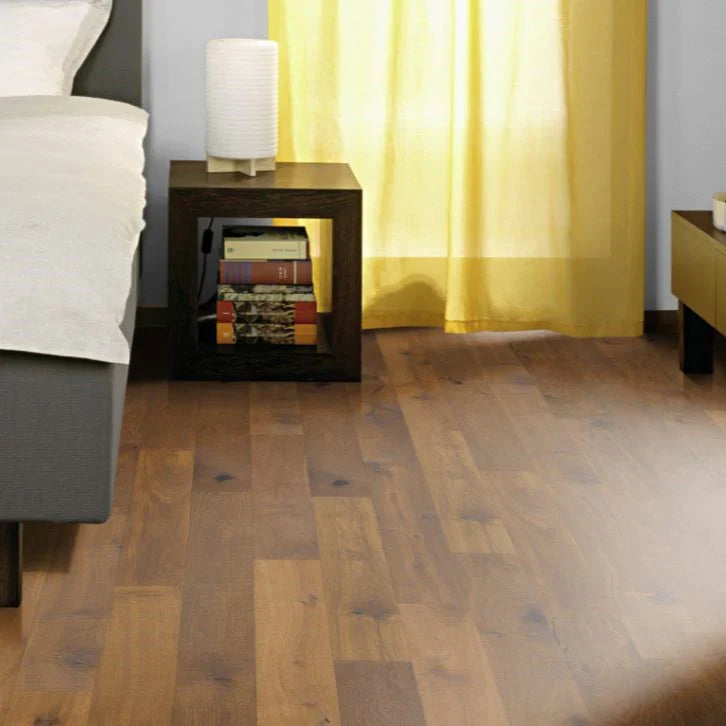
Author, Written by: P. Hirani (Wood flooring Expert)
Layering rugs might sound like a trend borrowed from a design magazine—but it’s surprisingly practical and easy to pull off. Whether you have hardwood, laminate, or vinyl flooring, layering rugs is a clever way to add warmth, texture, and personality to your space without a complete overhaul.
Here’s how to do it right.
1. Start with the Right Base Rug 🧺
Your bottom layer sets the tone—so go for a rug that’s neutral, flatwoven, and large enough to ground your furniture.
✔ Think jute, sisal, or low-pile wool for a versatile base.
✔ Stick with natural shades like beige, taupe, or grey to let your top layer shine.
✔ Ideally, your base rug should extend beyond your furniture setup, especially in living and dining areas.
🔹 Tip: If your flooring is darker (like walnut or espresso oak), a lighter base rug adds contrast and helps brighten up the room.
2. Add a Smaller, Statement Rug on Top 🎯
This is where you get to play with pattern, colour, and texture.
✔ Choose a smaller rug—roughly 60–70% the size of the base rug.
✔ Experiment with bold geometrics, vintage Persian styles, faux fur, or distressed patterns.
✔ Make sure the top rug doesn’t completely cover the base; the contrast is key to making it look layered—not like a mistake.
🔹 Tip: For vinyl or laminate floors, a soft wool or cotton rug on top can add a cozy feel and soften any echo or hardness underfoot.
3. Play with Angles (But Don’t Overdo It) ↘️
Want to give your space a bit of personality? Don’t just stack rugs perfectly on top of each other.
✔ Try placing the top rug at a slight angle or off-centre to break up symmetry and create a lived-in look.
✔ In smaller rooms, this can make the area feel more spacious and visually dynamic.
🔹 Avoid: Lining everything up too neatly can look stiff. Slight imperfections make it feel intentional and cozy.
4. Mix Textures for Depth and Interest ✨
Layering isn’t just about what you see—it’s also about how it feels.
✔ Combine rougher textures (like sisal) with plush ones (like shag or chenille).
✔ Faux hides or fluffy rugs add instant coziness, especially in bedrooms and reading nooks.
🔹 Bonus: Texture layering also helps highlight different zones in open-plan living spaces—like a reading corner versus a dining area.
5. Don’t Forget the Rug Pad! 🔧
If you’re layering on hard flooring, a non-slip rug pad is essential.
✔ It prevents slipping, bunching, and premature wear.
✔ Adds a bit of extra cushioning, making hard floors more comfortable to walk or sit on.
🔹 Tip: You can use double-sided carpet tape for thinner layers, especially in high-traffic areas.
Some Quick Styling Ideas
✔ In the Living Room: Jute base + Moroccan shag on top.
✔ In the Bedroom: Low-pile neutral rug + faux sheepskin on either side of the bed.
✔ In the Hallway: Natural runner + vintage accent rug at the entrance.
Wrapping It Up (Without Saying “Final Thoughts”)
Layering rugs on hard floors is one of those design tricks that looks high-end but doesn’t have to break the bank. It brings together the best of both worlds—visual appeal and practical comfort. Plus, it’s easy to swap out rugs with the seasons or as your style evolves.
Thinking of trying it out? Start with a base rug you already own and build from there. You might be surprised by how much cozier your space feels with just a little layering magic. 🪄
About Author:
Peter H. is a flooring product expert who knows all about different types of flooring materials. He shares his knowledge in blogs to help readers make the best choices for their spaces.
